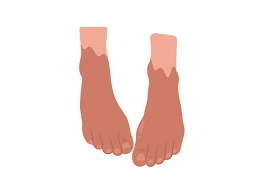Suffer From Heel Pain
If you suffer from heel pain, a disease may be under the surface. Heel pain can be caused by systemic arthritic disorders such as rheumatoid and psoriatic. Other conditions can cause heel pain, such as crystal deposition arthritis, Paget’s Disease, and Diffuse Idiopathic Skeletal Hyperostosis. Below are some brief definitions of these conditions and information on what can cause heel pain.
Rheumatoid Arthritis
This autoimmune condition causes chronic inflammation and damages structures surrounding joints. This Disease can cause heel pain, even though it usually causes pain in the tiny hands and feet joints. Inflammatory factors can cause heel pain due to swelling and pain. This includes bursae, fluid-filled sacs in various parts of the human body. The area around the heel has two main bursae, and the Achilles tendon inserts on the heel bone. This area is predisposed in several ways. The protective fat pads at the heel and ball of the foot are also worn down by rheumatoid Arthritis. This causes pain in the ball of your foot but can also occur in the heel.
Psoriatic Arthritis is another autoimmune condition that can cause joint pain and swelling. In some ways, it is similar to rheumatoid, but the pattern of affected joints differs. The skin and nails may also change in appearance. Psoriatic Arthritis causes heel pain for the same reason as rheumatoid. The inflammation in the structures surrounding the heel bone is the cause.
Crystal deposition arthritis
This type includes gout and a condition called CPPD (or Calcium Pyrophosphate Deposition). These two arthritic disorders are both caused by crystals that the body creates in joints and tendons. The crystals that form in gout and CPPD are different. The Achilles tendon is located in the heel, which makes it more susceptible to being affected by these crystals. Gout affects more people than CPPD; gout affects mainly men, while CPPD affects primarily women.
Paget’s Disease
This chronic bone condition causes osteoclast activity (bone-absorbing activity) to be more active than osteoblast activity (bone-making activity). The osteoblasts’ exercise increases as they try to build more bone. This leads to a chaotic process and haphazardly laid down bone. The bone becomes more dense and large but also more fragile and weak. Paget’s causes pain in the heel due to excessive bone activity and (in worst cases) fractures.
This condition is also known as DISH or Foreistier’s Disease. It occurs when the body produces bone where ligaments attach to bones. On an x-ray, this condition looks like a bone spur. This condition causes pain due to the pressure created by the triggers and the stiffness caused by the bone growth in areas with flexibility and motion.
Reiter’s Disease is also called “reactive arthritis.” An underlying infection usually causes it. It was first described in World War I when a doctor noticed that soldiers developed joint pain following bouts of diarrhea caused by an intestinal infection. Reiter’s is usually caused by genitourinary or sexually transmitted diseases. Reiter’s can cause significant or small bone spurs in the heel of patients who would otherwise be too young to develop them.
Sickle Cell Anemia is a condition that changes the shape of red cells. This change in form makes the red blood cell more likely to stick and clump together. This genetic condition can cause heel pain due to the blood cells clumping and not supplying oxygen to the heel bone. It can lead to the death of some cells in the heel bone. This death (necrosis) is excruciating. This is starving/strangling of the heel bone.
Diabetes
If uncontrolled properly, diabetes can affect nearly every organ or part of the human body. People with diabetes often experience heel pain due to uncontrolled blood sugars, which damage the conductive nerve lining over time. Myelin is a protective layer that surrounds nerves. It protects them from the environment and amplifies nerve signals throughout the body. Myelin damage causes nerves to be unable to transmit standard signals, leading to painful symptoms like burning, tingling, or numbness.
It is important to remember that many of the conditions mentioned above are the exceptions to heel pain. They can be the “zebras” amongst the “horses.” It is essential to keep this in mind if the treatments for plantar fasciitis do not work as well as you expected. Blood tests and a full assessment by your doctor are used to diagnose the diseases described.
Credit: NoRXPharmaUSA.com
